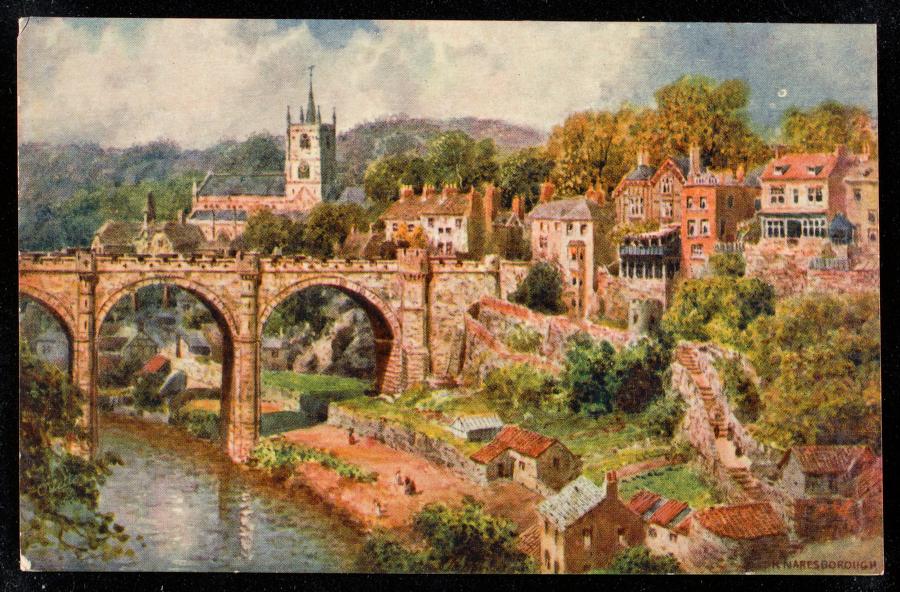
The Knaresborough Viaduct over the River Nidd in Nidderdale. Designed by the railway engineer Thomas Grainger (1794-1852). The Grade II* listed structure was completed in 1851. According to the listing text it is about "100 metres long and 30 metres high, carrying 2 tracks on 4 arches." The descriptive notes continue: "2 central round arches span the river, the 2 flanking arches span the Long Walk (south bank) and Waterside (north bank). Round cut-waters carried up as buttresses with projecting bands and small half-towers at top. Embattled parapet."
In 1846 the Leeds and Thirsk Railway gained permission "to extend their Knaresborough Branch across the river Nidd into the town of Knaresborough (1/2 mile)" (Tomlinson 478); work on a new viaduct duly commenced in the early spring of 1847, but when the line was opened a year later, in March 1848, it only went up to Haypark Lane, still half a mile short of the river — "the works beyond being yet unfinished owing to the fall, on the 11th March, 1848, of the Nidd Viaduct, when just on the point of completion" (Tomlinson 488). In fact, the viaduct had collapsed with a mighty roar just before the branch line was due to open. The Illustrated London News of 18 March 1848 carried the following brief announcement:
Destruction of the Viaduct over the River Nidd at KNARESBOROUGH — On Saturday, about half-past eleven, a.m., the entire viaduct, which was near being completed, fell in with a tremendous crash. It consisted of four arches (the centres of which had not been removed), each fifty feet span and eighty feet high. The cause of so great a catastrophe remains a mystery yet to be explained, but it is thought it has arisen in a great measure through the heavy rains which have prevailed for the last two months. — Fortunately, no lives were lost. It was intended for the use of the Leeds and Thirsk, York and North Midland, and East and West Yorkshire Junction Railways. [181]
Without any official enquiry, the true cause or causes of the disaster could not have been known, but there might well have been a suspicion of workmanship problems as well as weather-related ones, since the contractors were changed for the rebuilding. The listing text states that "the replacement cost £9,803 to construct."

Tuck's postcard of the same view,
dated 1903-59.
Once the new viaduct was completed by a different firm of contractors, its castle-like features proved controversial: Nikolaus Pevsner, outspoken as ever, memorably dubbed it "one of the most notable railway crimes in England" (qtd. in Leach and Pevsner 380). But that did not prevent the picturesque structure from becoming a well-known attraction. For example, it provides the frontispiece for A. W. Lowe's Album of Knaresbrough Views, published in 1900.
Photograph by Colin Price. Postcard scan, commentary and formatting by Jacqueline Banerjee. [You may use these images without prior permission for any scholarly or educational purpose as long as you (1) credit the photographer/person who scanned the image and (2) link your document to this URL in a web document or to the Victorian Web in a print document.]
Bibliography
Album of Knaresbrough Views. Knaresborough: A.W. Lowe, 1900. Internet Archive, from a copy in the Wellcome Library. Web. 12 May 2025.
"Destruction of the Viaduct...." The Illustrated London News, 18 March 1848: 181. Internet Archive. Web. 12 May 2025.
Knaresborough. Raphael Tuck & Sons. Internet Archive, contributed by the Newberry Library. Web. 12 May 2025.
Leach, Peter, and Nikolaus Pevsner. Yorkshire West Riding: Leeds, Bradford and the North. New Haven: Yale University Press, 2009.
Railway Viaduct over the River Nidd. Historic England. Web. 12 May 2025.
Thomas Grainger. Grace's Guide to British Industrial History. Web. 12 May 2025.
Tomlinson, William Weaver. The North Eastern Railway, its Rise and Development. Newcastle: Andrew Reid & Co., [1915]. Internet Archive, from a copy in the University of California Libraries. Web. 12 May 2025.
Created 12 May 2025